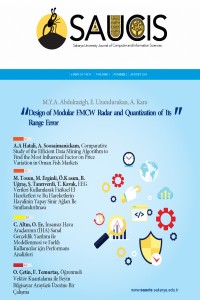İnsansız Hava Araçlarının (İHA) Sanal Gerçeklik Yazılımı ile Modellenmesi ve Farklı Kullanıcılar için Performans Analizleri
Abstract
Nowadays, many vehicles are desired to be controlled autonomously. Because of the most important application areas of these studies are military and health area, the development of simulation environments, providing more convenient tools and facilities both time and economically. By means of a 3D virtual reality software developed here, both EEG and EMG signals received from different users are parallely classified in the MATLAB and sent as commands to the virtual reality environment and the unmanned aerial vehicle can be remotely controlled. To test the system's performance, performance analyzes were performed using different routes on different subjects. In this view, independently from hardware the virtual reality environment is integrated with the signals obtained from the human, and the results show that the system can be used successfully.
References
- Altin C and Er O. 2017. “Designing wearable joystick and performance comparison of EMG classification methods for thumb finger gestures of joystick control.”, Biomed Res India 28: 4730-4736.
- Altin C and Er O. 2016. “Comparison of different time and frequency domain feature extraction methods on elbow gesture’s EMG”, Eur. J. Interdiscip. Stud., vol. 5, no. 1, pp. 35-44.
- Altin C. 2017. “Control of Four Rotor Unmanned Aerial Vehicle with Visual Feedback via Combined EEG and EMG Biological Signals” Ph.D Thesis, Yozgat Bozok University.
- Dulantha Lalitharatne T., Teramoto K., Hayashi Y. and Kiguchi K. 2013. “Towards Hybrid EEG-EMG-Based Control Approaches to be Used in Bio-robotics Applications: Current Status, Challenges and Future Directions”, PALADYN J. Behav. Robot. Rev. Artic., vol. 4, no. 2, pp. 147-154.
- MATLAB Documentation. 2004. Version 7.0, Release 14. The MathWorks, Inc.
- Mcadams E. 2011. “Bio-Medical CMOS ICs”, Springer, no. December 2010, pp. 31–124.
- Reilly RB. and Lee TC. 2010. “Electrograms (ECG, EEG, EMG, EOG)”, Technol. Heal. Care, vol. 18, no. 6, pp. 443-458, Jan.
- Sturman DJ. and Zeltzer D. 1994. “A survey of glove-based input,” IEEE Comput. Graph. Appl., vol. 14, no. 1, pp. 30–39, Jan.
- Unity Technologies. 2018. Unity 3D. http://unity3d.com/.
- Vaughan TM., Wolpaw JR. and Donchin E. 1996. “EEG-based communication: prospects and problems.”, IEEE Trans. Rehabil. Eng., vol. 4, no. 4, pp. 425–30, Dec.
- Wolpaw JR., Birbaumer N., McFarland DJ., Pfurtscheller G. and Vaughan TM. 2002. “Brain-computer interfaces for communication and control.”, Clin. Neurophysiol., vol. 113, no. 6, pp. 767–91, Jun.
- Wolpaw JR., McFarland DJ. and Vaughan TM. 2000. “Brain-computer interface research at the Wadsworth Center.” IEEE Trans. Rehabil. Eng., vol. 8, no. 2, pp. 222–6, Jun.
İnsansız Hava Araçlarının (İHA) Sanal Gerçeklik Yazılımı ile Modellenmesi ve Farklı Kullanıcılar için Performans Analizleri
Abstract
Günümüzde birçok araç otonom olarak kontrol edilmek istenmektedir. Bu çalışmaların en önemli uygulama alanlarının başında askeri ve sağlık alanları olması münasebeti öncelik arz etmektedir. Bunun amaç için simülasyon ortamlarının geliştirilmesi hem zaman hem de ekonomik olarak daha elverişli araçlar ve imkanlar sunmaktadır. Buradan hareketle geliştirilen bir 3D sanal gerçeklik yazılımı sayesinde farklı kullanıcıdan alınan hem EEG hem de EMG sinyalleri paralel olarak MATLAB ortamına aktarılmış olup bu sinyaller sınıflandırılarak sanal oyuna komut olarak aktarılmış ve insansız hava aracı uzaktan yönlendirile bilinmiştir. Sistemin başarısını test etmek için farklı denekler üzerinde oluşturulan farklı rotalar kullanılarak performans analizleri yapılmıştır. Bu sayede donanımdan bağımsız olarak insandan elde edilen sinyaller ile sanal gerçeklik ortamı bütünleştirilmiş ve yapılan deneyler sonucunda başarılı bir şekilde kullanılabileceği sonucuna varılmıştır.
References
- Altin C and Er O. 2017. “Designing wearable joystick and performance comparison of EMG classification methods for thumb finger gestures of joystick control.”, Biomed Res India 28: 4730-4736.
- Altin C and Er O. 2016. “Comparison of different time and frequency domain feature extraction methods on elbow gesture’s EMG”, Eur. J. Interdiscip. Stud., vol. 5, no. 1, pp. 35-44.
- Altin C. 2017. “Control of Four Rotor Unmanned Aerial Vehicle with Visual Feedback via Combined EEG and EMG Biological Signals” Ph.D Thesis, Yozgat Bozok University.
- Dulantha Lalitharatne T., Teramoto K., Hayashi Y. and Kiguchi K. 2013. “Towards Hybrid EEG-EMG-Based Control Approaches to be Used in Bio-robotics Applications: Current Status, Challenges and Future Directions”, PALADYN J. Behav. Robot. Rev. Artic., vol. 4, no. 2, pp. 147-154.
- MATLAB Documentation. 2004. Version 7.0, Release 14. The MathWorks, Inc.
- Mcadams E. 2011. “Bio-Medical CMOS ICs”, Springer, no. December 2010, pp. 31–124.
- Reilly RB. and Lee TC. 2010. “Electrograms (ECG, EEG, EMG, EOG)”, Technol. Heal. Care, vol. 18, no. 6, pp. 443-458, Jan.
- Sturman DJ. and Zeltzer D. 1994. “A survey of glove-based input,” IEEE Comput. Graph. Appl., vol. 14, no. 1, pp. 30–39, Jan.
- Unity Technologies. 2018. Unity 3D. http://unity3d.com/.
- Vaughan TM., Wolpaw JR. and Donchin E. 1996. “EEG-based communication: prospects and problems.”, IEEE Trans. Rehabil. Eng., vol. 4, no. 4, pp. 425–30, Dec.
- Wolpaw JR., Birbaumer N., McFarland DJ., Pfurtscheller G. and Vaughan TM. 2002. “Brain-computer interfaces for communication and control.”, Clin. Neurophysiol., vol. 113, no. 6, pp. 767–91, Jun.
- Wolpaw JR., McFarland DJ. and Vaughan TM. 2000. “Brain-computer interface research at the Wadsworth Center.” IEEE Trans. Rehabil. Eng., vol. 8, no. 2, pp. 222–6, Jun.
Details
| Primary Language | Turkish |
|---|---|
| Subjects | Computer Software |
| Journal Section | Articles |
| Authors | |
| Publication Date | August 1, 2018 |
| Submission Date | July 25, 2018 |
| Acceptance Date | August 2, 2018 |
| Published in Issue | Year 2018 Volume: 1 Issue: 2 |
Cite
Cited By
İnsansız Hava Araçları ve Otopilotlar
Journal of Aviation Research
https://doi.org/10.51785/jar.894721
The papers in this journal are licensed under a Creative Commons Attribution-NonCommercial 4.0 International License


